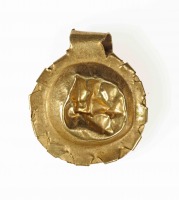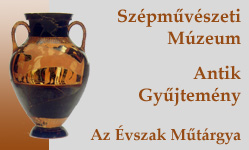Amulets in ancient jewellery
Highlighted Works of Art - 2011 Winter
One of the most heated debates in the current study of classical antiquity focuses on the relationship between magic and religion. The argument, unusually passionate - the significance of which far exceeds its own narrower field of scholarship - centered around one great dichotomy: is it indeed possible to separate magic and religion in the ancient Mediterranean, as so many previous generations did?
The question has by now been settled: in ancient cultures magic considered as a dark force opposite to religion was far from being a universal concept. It is impossible to say whether a single rite in itself is 'religious' or 'magical'. In Book I of
The Iliad the priest of Apollo turns with a harmful prayer to his god, who then sends a plague on the Greeks besieging Troy. Magic from one perspective was divine worship from the other. The study of classical antiquity has thus joined today's
communis opinio, for which the great dichotomy between magic and religion has long disappeared. Today we can only speak of ancient magic as a general concept in the everyday sense of the word.
 |
| 1 |
The objects on display clearly show how 'magic' formed a natural part of everyday life: we present jewellery which also gave protection to their wearers as amulets. All of them lack a provenance and can thus only be assigned a general interpretation. The bulk of the jewellery is gold. In several ancient cultures magical and healing power were assigned to this precious metal.
 |
| 2 |
An amulet or talisman is a magical means of protection. The term is generally used for personal objects, even though a more general use of the word is also justified. The Greek and Latin languages abounded in words meaning 'talisman' - this fact in itself is an indication of their widespread use. The names may have referred to the way they were worn (
periapton: a ribbon
tied around the wrist or the ankle), their protective function (
phylakterion: protective object) or the shape of the object (
lunula:
crescent shaped pendant).
 |
| 3 |
Talismans were made in numerous shapes and materials. As most of them were produced from organic materials, their memory is only preserved in ancient art and literature. Some types, however, have survived as material remains. Their amuletic function is suggested by their characteristic motifs and unique shapes. They were not hidden, but worn in a clearly visible way.
 |
| 4 |
In the period of the Roman Empire lentil-shaped, cylindrical or rectangular hollowed 'capsules' made of sheet gold served as mounts for different objects which were believed to have apotropaic or healing power. The capsules could contain seeds, bits of vegetation, pieces of textile, and even papyri or metal tablets with magical inscriptions. The folds in the Greek papyrus against fever (1) suggest that it was probably kept in a cylindrical capsule. The lentil-shaped capsule (2) and the rectangular capsule divided into five spheres (3) still preserve their contents: based on their sound they enclose several tiny, hard objects. These ornaments were hung on short necklaces. Roman tradition believed the lentil-shaped version (
bulla) to be of Etruscan origin. It was worn by free-born young boys.
 |
| 5 |
In the Imperial period, its use became much more widespread: examples have mainly been recovered from the tombs of women and children. The piece on display dates to the 3rd century. The downward-broadening, cylindrical pendant with three rows of drop-shaped filigree decoration on its surface (4) is also of a characteristic shape, recalling the club of the par excellence hero in Greek mythology: Heracles
alexikakos, 'averter of evil'. The drop-shaped decorations imitate the places of the truncated branches.
 |
| 6 |
Similar pieces are known from the second half of the Imperial period. Excavations have shown that in the Imperial period club-shaped pendants were also primarily worn by women and children, and hung both on necklaces and earrings. Although the amuletic function of the club is attested by written sources, lacking textual evidence it is impossible to say whether individual pieces of jewellery were regarded as decoration or amulets by their users. At the moment this very uncertainty is a major shared feature of interpretations of ancient amuletic jewellery.
 |
| 7 |
It was a common belief that a knot can bind evil: its tying or untying was of magical significance. The most frequent type among ancient amulets was the weaver's knot, which had its own name in Greek and Latin as well: Heracles-knot (
Herakleion hamma, nodus Herculaneus). The universal magic of binding and freeing was worded in the language of mythology. According to ancient iconographical tradition, Heracles draped himself with the impenetrable hide of the defeated Nemean lion and tied with this knot. As a motif in jewellery, the knot may always have evoked this protective function. In all probability, it became a frequent motif in Greek gold jewellery in Macedonia in the second half of the fourth century BC, the age of Philip II and Alexander the Great.
 |
| 8 |
In the Hellenistic period it appeared on diadems, wreaths and rings alike, and often decorated necklaces combined with lion heads. This is exemplified by the necklace fragment datable to circa 310-250: originally the hook and loop decorated with a Heracles-knot was framed by two lion heads (5). In the Roman period the Heracles-knot was mostly used on necklaces. In the second and third centuries AD a flat two-dimensional version came into fashion, which was threaded into a necklace alternating with stone beads (6). From the second half of the 3rd century several treasure finds from the western part of the Roman Empire contain necklaces decorated with the Heracles-knot.
 |
| 9 |
One of them is the piece from Rábakovácsi, made of three-dimensional Heracles-knot elements and green stone beads (7). Based on the gold coins decorating the necklace as pendants it was made in the second half of the 250s AD. The emperor-portraits on the coins may also have served as amulets.
Another characteristic apotropaic motif on amulets is the terrifying face of the Gorgon, who turned everything into stone. The Greek version of this monster present in many Mediterranean cultures was also interpreted through a mythical story (in mythology the Gorgon was defeated by Perseus, the son of Zeus).
 |
| 10 |
The Gorgoneion appeared on the shield of the goddess Athene, on antefixes surrounding the roofs of temples and also on everyday objects. In the second half of the fourth century BC, the Greek goldsmith creating the gold fibula in the shape of a shield fitted the Gorgon's head in the middle of the fibula (8). Gorgoneia made of sheet gold may also have served as centerpieces for necklaces in the second and third centuries AD. The type is also well known from painted mummy-portraits from contemporary Egypt. As similar pieces attest, such a necklace was worn by the woman represented on the life-size mummy portrait on display (9). In triumphal processions after victorious battles, soldiers may have decorated their breast-plates with relief disks made of silver or bronze representing the Gorgon's head. The silver tablet of first- or second-century date (10) with the embossed image of the Gorgoneion surrounded by snakes coiling in her hair must have been such a breast-plate ornament as well.
Marianna Dági - Árpád M. Nagy
The Rábakovácsi necklace: on loan from the Roman Collection of the Hungarian National Museum.
We are grateful for the support of OTKA Grant no. K81332.











